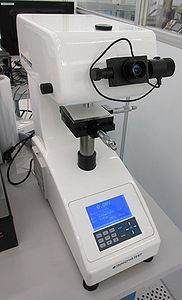Specific Process Knowledge/Characterization/Hardness measurement: Difference between revisions
| Line 1: | Line 1: | ||
'''Feedback to this page''': '''[mailto:labadviser@danchip.dtu.dk?Subject=Feed%20back%20from%20page%20http://labadviser.danchip.dtu.dk/index.php/Specific_Process_Knowledge/Characterization/Hardness_measurement click here]''' | '''Feedback to this page''': '''[mailto:labadviser@danchip.dtu.dk?Subject=Feed%20back%20from%20page%20http://labadviser.danchip.dtu.dk/index.php/Specific_Process_Knowledge/Characterization/Hardness_measurement click here]''' | ||
Revision as of 11:01, 6 February 2018
Feedback to this page: click here
Hardness tester

The purpose is to measure hardness of samples or films. This is done by pressing an indenter (a small pyramid-shaped diamond tip) into a sample using a known indentation force. This leaves an indent in the sample. The hardness of the sample can then be derived from the dimensions of the indentation (the softer the material the larger the indentation). The samples should have a reasonably low roughness. Otherwise it can be quite difficult to determine the roughness reliably.
The user manual, technical information and contact information can be found in LabManager:
Equipment info for: Hardness tester
Quality Control - Recipe Parameters and Limits
| Quality Control (QC) for the hardness tester |
|
There is no scheduled calibration of this machine. We do however have three calibration samples which can be used to verify proper operation of the machine. The calibration samples are also good for practicing the measurement procedure. Calibration samples are available in the following three hardnesses: 277 HV, 464 HV and 704 HV. They have been calibrated externally at 1 kgf indentation force and 10 sec indentation time. |
|
Purpose |
Hardness tester |
|
|---|---|---|
|
Performance |
Available test forces |
|
|
Data output |
| |
|
Substrates |
Batch size |
|
|
Substrate materials allowed |
| |
|
Calibration samples available |
|
